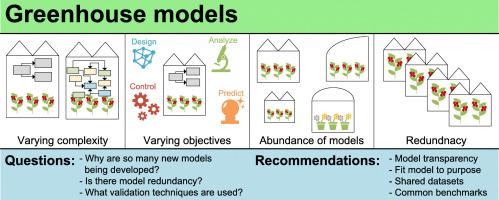Agricultural Systems ( IF 6.1 ) Pub Date : 2022-02-24 , DOI: 10.1016/j.agsy.2022.103388 David Katzin 1, 2 , Eldert J. van Henten 1 , Simon van Mourik 1

|
CONTEXT
Process-based greenhouse climate models are valuable tools for the analysis and design of greenhouse systems. A growing number of greenhouse models are published in recent years, making it difficult to identify which components are shared across models, which are new developments, and what are the objectives, strengths and weaknesses of each model.
OBJECTIVE
We present an overview of the current state of greenhouse modelling by analyzing studies published between 2018 and 2020. This analysis helps identify the key processes considered in process-based greenhouse models, and the common approaches used to model them. Moreover, we outline how greenhouse models differ in terms of their objectives, complexity, accuracy, and transparency.
METHODS
We describe a general structure of process-based greenhouse climate models, including a range of common approaches for describing the various model components. We analyze recently published models with respect to this structure, as well as their intended purposes, greenhouse systems they represent, equipment included, and crops considered. We present a model inheritance chart, outlining the origins of contemporary models, and showing which were built on previous works. We compare model validation studies and show the various types of datasets and metrics used for validation.
RESULTS AND CONCLUSIONS
The analysis highlights the range of objectives and approaches prevalent in greenhouse modelling, and shows that despite the large variation in model design and complexity, considerable overlap exists. Some possible reasons for the abundance of models include a lack of transparency and code availability; a belief that model development is in itself a valuable research goal; a preference for simple models in control-oriented studies; and a difference in the time scales considered. Approaches to model validation vary considerably, making it difficult to compare models or assess if they serve their intended purposes. We suggest that increased transparency and availability of source code will promote model reuse and extension, and that shared datasets and evaluation benchmarks will facilitate model evaluation and comparison.
SIGNIFICANCE
This study highlights several issues that should be considered in greenhouse model selection and development. Developers of new models can use the decomposition provided in order to present their models and facilitate extension and reuse. Developers are encouraged to reflect on and explicitly state their model's range of suitability, complexity, validity, and transparency. Lastly, we highlight several steps that could be taken by the greenhouse modelling community in order to advance the field as a whole.
中文翻译:

基于过程的温室气候模型:系谱学、现状和未来方向
语境
基于过程的温室气候模型是分析和设计温室系统的宝贵工具。近年来发布的温室模型越来越多,因此很难确定哪些组件在模型之间共享,哪些是新的发展,以及每个模型的目标、优势和劣势是什么。
客观的
我们通过分析 2018 年至 2020 年间发表的研究来概述温室建模的当前状态。该分析有助于确定基于过程的温室模型中考虑的关键过程,以及用于对其进行建模的常用方法。此外,我们概述了温室模型在目标、复杂性、准确性和透明度方面的不同之处。
方法
我们描述了基于过程的温室气候模型的一般结构,包括一系列用于描述各种模型组件的常用方法。我们分析了最近发布的关于这种结构的模型,以及它们的预期目的、它们所代表的温室系统、包括的设备和考虑的作物。我们展示了一个模型继承图,概述了当代模型的起源,并展示了哪些是建立在以前的作品之上的。我们比较模型验证研究并展示用于验证的各种类型的数据集和指标。
结果和结论
该分析突出了温室建模中普遍存在的目标和方法的范围,并表明尽管模型设计和复杂性存在很大差异,但仍存在相当大的重叠。模型丰富的一些可能原因包括缺乏透明度和代码可用性;相信模型开发本身就是一个有价值的研究目标;在面向控制的研究中偏爱简单模型;以及所考虑的时间尺度的差异。模型验证的方法差异很大,因此很难比较模型或评估它们是否符合预期目的。我们建议增加源代码的透明度和可用性将促进模型重用和扩展,共享数据集和评估基准将促进模型评估和比较。
意义
本研究强调了温室模型选择和开发中应考虑的几个问题。新模型的开发人员可以使用提供的分解来展示他们的模型并促进扩展和重用。鼓励开发人员反思并明确说明其模型的适用性、复杂性、有效性和透明度范围。最后,我们强调了温室建模社区可以采取的几个步骤,以推动整个领域的发展。











































 京公网安备 11010802027423号
京公网安备 11010802027423号